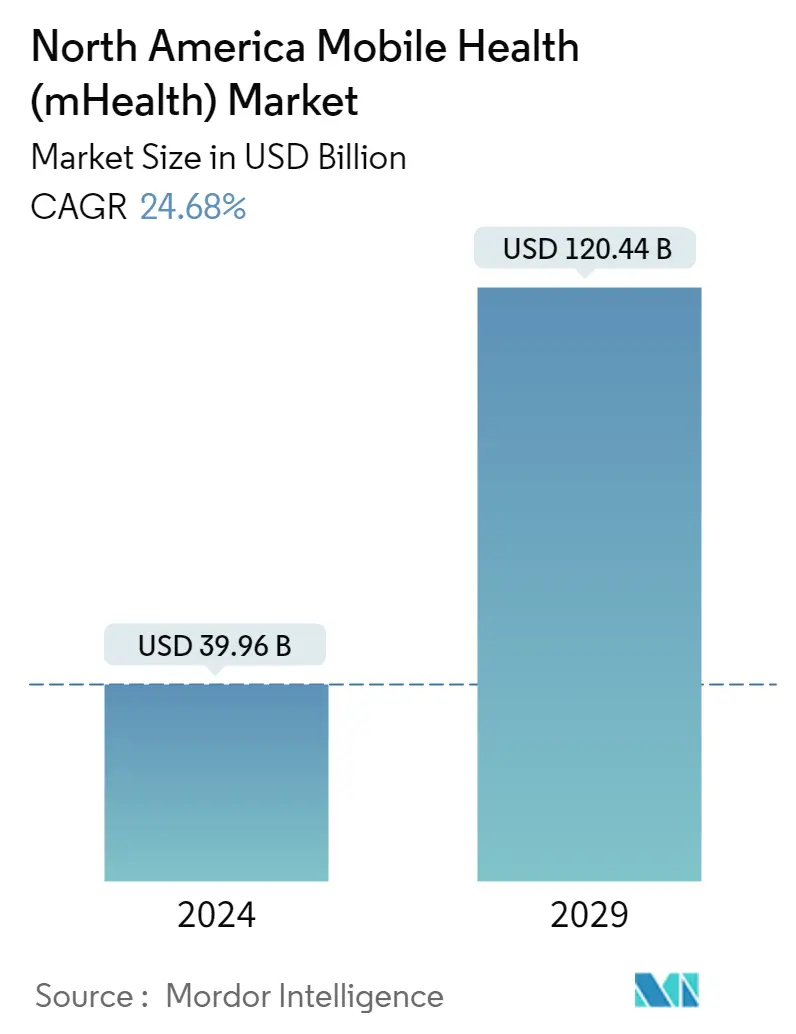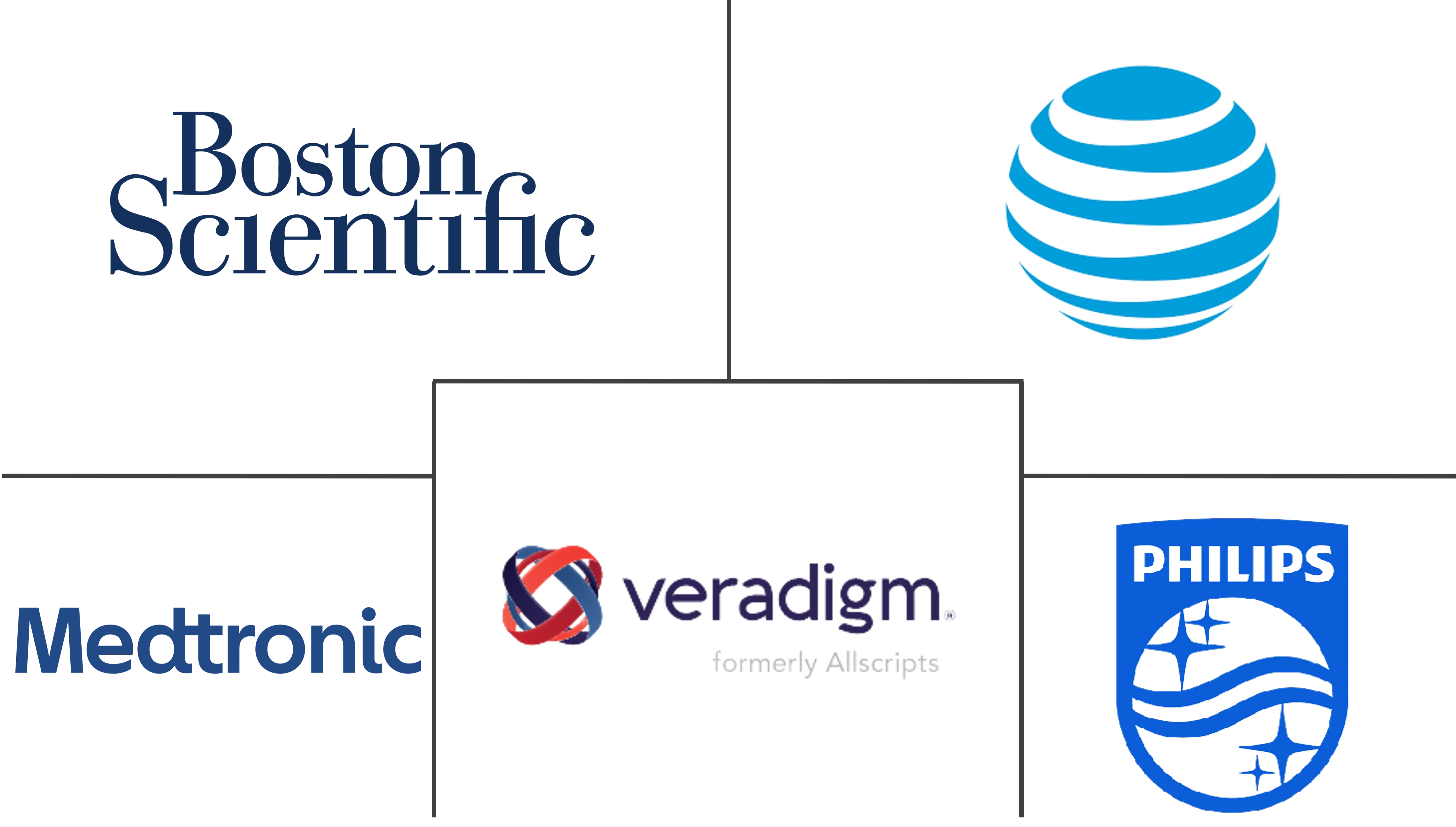Market Size of North America Mobile Health (mHealth) Industry

| Study Period | 2019 - 2029 |
| Base Year For Estimation | 2023 |
| Market Size (2024) | USD 39.96 Billion |
| Market Size (2029) | USD 120.44 Billion |
| CAGR (2024 - 2029) | 24.68 % |
| Market Concentration | Medium |
Major Players
*Disclaimer: Major Players sorted in no particular order |
North America Mobile Health Market Analysis
The North America Mobile Health Market size is estimated at USD 39.96 billion in 2024, and is expected to reach USD 120.44 billion by 2029, growing at a CAGR of 24.68% during the forecast period (2024-2029).
- North America's mobile health (mHealth) market was significantly impacted by the pandemic since software developers and service providers opted for advancing mobile health technologies and continuously focused on developing mHealth applications to provide patients with point-of-care diagnoses. The initiatives taken by the government to launch mobile health apps for COVID-19-related information also boosted the growth of the market during the pandemic.
- For instance, in January 2021, the Department of Health, Louisiana, United States, launched COVID Defense. It was Louisiana's free, easy-to-use phone app that provided residents of Louisiana the information needed to fight COVID-19 without compromising their privacy. Such launches in the country are expected to contribute to the growth of the market. In the coming years, the market is anticipated to witness fair growth owing to the increase in the adoption of mobile health technologies in health care and the rise in technological advancements in mHealth services across North America.
- The significant factors contributing to the market growth in the region are an increase in the use of smartphones and gadgets, a rise in investments in personalized medicine, and a rise in awareness towards early diagnosis of the treatment. Moreover, many key players are launching their mHealth-related products via smartphones and smart gadgets to the market, which is likely to be a driving factor for the market growth. For instance, in May 2021, SleepSmartz launched a new app that may help people who suffer from insomnia. In some cases, insomnia may be brought on by substance use, depression, post-traumatic stress disorder, suicidal thoughts, and/or a large amount of stress. When combined with the science of relaxation, SleepSmartz provides a powerful tool to overcome insomnia.
- Furthermore, strategic acquisitions by the key players are expected to increase the presence and product availability across North America. For instance, in November 2022, the Canadian network of medical clinics Elna Medical acquired of M-Health Solutions, a remote health diagnostics and monitoring solution provider.
- M-Health Solutions provides in-home cardiac diagnostic and real-time monitoring systems that include wearable ECG technologies (Holter monitors) and a cloud-based AI-enabled reporting service. Additionally, the advancements in the chronic disease sectors using mobile health are expected to increase the need for mHealth across the region. For instance, as per the article published in September 2021 in PubMed, Mobile health technologies (mHealth) are recognized by the American Heart Association as an emerging technique in reducing CVD risk factors, with tremendous potential for improving population health.
- Thus, due to the rise in the adoption of mHealth services and products across the region and the increase in technological advancements in mHealth, the studied market is expected to witness growth over the forecast period. However, data privacy issues associated with mHealth products and services are expected to hinder the growth of mobile health in the North American region.
North America Mobile Health Industry Segmentation
As per the scope of the report, mHealth (mobile health) is a general term for the use of mobile phones and other wireless technology in medical care. The most popular use of mHealth is to educate consumers about preventive healthcare services via mobile devices. The National Institutes of Health (NIH) defined mHealth as the use of mobile and wireless devices (that includes cell phones, tablets, etc., patient monitoring devices, and personal digital assistants (PDAs)) to improve health outcomes, health care services, and health research.
The North American mobile health (mhealth) market is segmented by service type (treatment services (independent aging solutions, and chronic disease management), diagnostic services, monitoring services (remote patient monitoring devices, medical call centers manned by healthcare professionals, telemedicine solutions, and post-acute care services), wellness and fitness solutions, and other services), device type (blood glucose monitors, cardiac monitors, hemodynamic monitors, neurological monitors, respiratory monitors, body, and temperature monitors, remote patient monitoring devices, and other device types), stakeholder (mobile operators, healthcare providers, application/content players), and geography (United States, Canada, and Mexico).
The report offers the values (USD million) for the above segments.
| By Service Type | ||||||
| ||||||
| Diagnostic Services | ||||||
| ||||||
| Wellness and Fitness Solutions | ||||||
| Other Services |
| By Device Type | |
| Blood Glucose Monitors | |
| Cardiac Monitors | |
| Hemodynamic Monitors | |
| Neurological Monitors | |
| Respiratory Monitors | |
| Body and Temperature Monitors | |
| Remote Patient Monitoring Devices | |
| Other Device Types |
| By Stake Holder | |
| Mobile Operators | |
| Healthcare Providers | |
| Application/Content Players |
| Geography | |
| United States | |
| Canada | |
| Mexico |
North America Mobile Health (mHealth) Market Size Summary
The North America mobile health (mHealth) market is poised for substantial growth, driven by the increasing adoption of mobile health technologies and advancements in mHealth services. The market experienced a significant boost during the pandemic as software developers and service providers accelerated the development of mHealth applications to facilitate point-of-care diagnoses. Government initiatives, such as the launch of mobile health apps for COVID-19 information, further propelled market expansion. The rise in smartphone usage, investments in personalized medicine, and heightened awareness of early diagnosis are key factors contributing to the market's growth. Strategic product launches and acquisitions by major players, along with advancements in chronic disease management using mobile health technologies, are expected to enhance market presence and product availability across the region.
The United States is anticipated to hold a significant share of the North American mHealth market, supported by high healthcare expenditures, a strong presence of key players, and substantial government funding for telehealth and healthcare data science research. The growing prevalence of mental health and neurological diseases is expected to drive demand for mobile health solutions. Innovations such as AI-powered wearable devices for respiratory health monitoring exemplify the technological advancements fueling market growth. The fragmented nature of the market, with numerous key players focusing on expanding distribution channels and reaching diverse healthcare facilities, further underscores the competitive landscape. These dynamics, coupled with the increasing government investment in digital healthcare, position the North American mHealth market for robust growth over the forecast period.
North America Mobile Health (mHealth) Market Size - Table of Contents
-
1. MARKET DYNAMICS
-
1.1 Market Overview
-
1.2 Market Drivers
-
1.2.1 Increasing Use of Smart Consumer Devices for Varied Applications
-
1.2.2 Increasing Investments in Personalized Medicine and Patient Centric Approach
-
1.2.3 Increasing Awareness and Demand for Point of Care Diagnosis and Treatment
-
-
1.3 Market Restraints
-
1.3.1 Data Privacy Issues
-
-
1.4 Porter's Five Forces Analysis
-
1.4.1 Threat of New Entrants
-
1.4.2 Bargaining Power of Buyers/Consumers
-
1.4.3 Bargaining Power of Suppliers
-
1.4.4 Threat of Substitute Products
-
1.4.5 Intensity of Competitive Rivalry
-
-
-
2. MARKET SEGMENTATION (Market Size by Value - USD million)
-
2.1 By Service Type
-
2.1.1 Treatment Services
-
2.1.1.1 Independent Aging Solutions
-
2.1.1.2 Chronic Disease Management
-
-
2.1.2 Diagnostic Services
-
2.1.3 Monitoring Services
-
2.1.3.1 Remote Patient Monitoring Devices
-
2.1.3.2 Medical Call Centers Manned by Healthcare Professionals
-
2.1.3.3 Telemedicine Solutions
-
2.1.3.4 Post Acute Care Services
-
-
2.1.4 Wellness and Fitness Solutions
-
2.1.5 Other Services
-
-
2.2 By Device Type
-
2.2.1 Blood Glucose Monitors
-
2.2.2 Cardiac Monitors
-
2.2.3 Hemodynamic Monitors
-
2.2.4 Neurological Monitors
-
2.2.5 Respiratory Monitors
-
2.2.6 Body and Temperature Monitors
-
2.2.7 Remote Patient Monitoring Devices
-
2.2.8 Other Device Types
-
-
2.3 By Stake Holder
-
2.3.1 Mobile Operators
-
2.3.2 Healthcare Providers
-
2.3.3 Application/Content Players
-
-
2.4 Geography
-
2.4.1 United States
-
2.4.2 Canada
-
2.4.3 Mexico
-
-
North America Mobile Health (mHealth) Market Size FAQs
How big is the North America Mobile Health (mHealth) Market?
The North America Mobile Health (mHealth) Market size is expected to reach USD 39.96 billion in 2024 and grow at a CAGR of 24.68% to reach USD 120.44 billion by 2029.
What is the current North America Mobile Health (mHealth) Market size?
In 2024, the North America Mobile Health (mHealth) Market size is expected to reach USD 39.96 billion.

